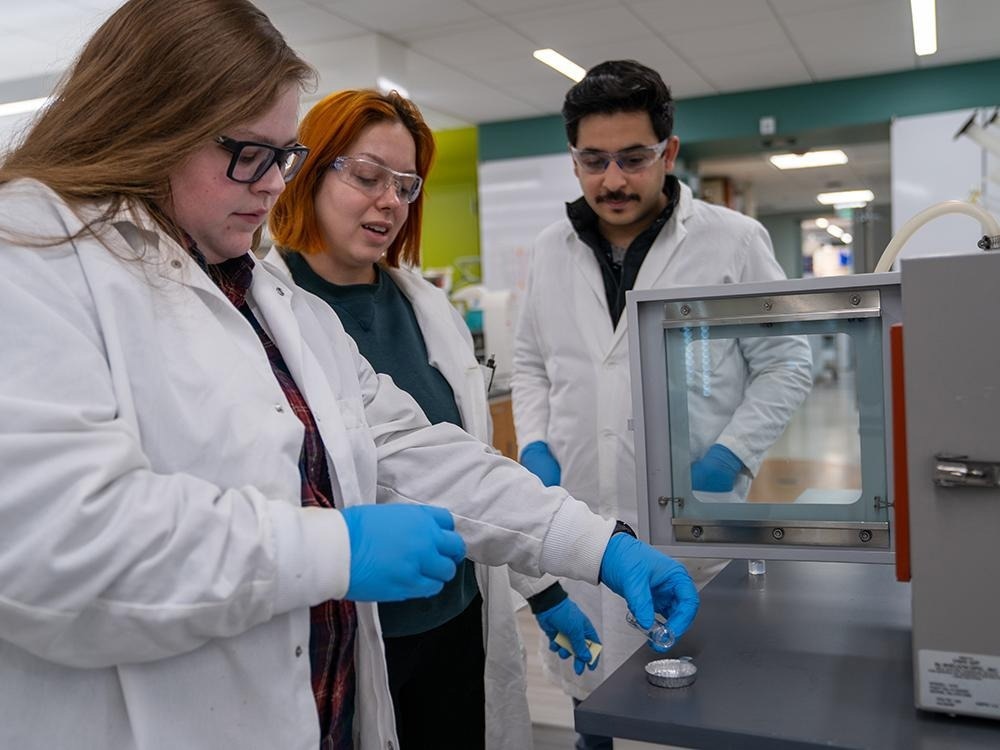Reviewed by Alex SmithJan 12 2023
Cellulose nanocrystals are bio-based nanomaterials that have been derived from natural resources like plant cellulose. They are considered useful in water treatment, tissue engineering, packaging, electronics, antibacterial coatings, and many more.
 First author Breanna Huntington (left), current chemical engineering graduate student at the University of Delaware and former member of the Sheikhi Research Group, readies a sample of hairy cellulose nanocrystals to dry in an oven. Co-authors Mica Pitcher (center), Penn State doctoral student in chemical engineering, and Amir Sheikhi (left), Penn State assistant professor of chemical engineering, look on. Image Credit: Jeff Xu/Penn State.
First author Breanna Huntington (left), current chemical engineering graduate student at the University of Delaware and former member of the Sheikhi Research Group, readies a sample of hairy cellulose nanocrystals to dry in an oven. Co-authors Mica Pitcher (center), Penn State doctoral student in chemical engineering, and Amir Sheikhi (left), Penn State assistant professor of chemical engineering, look on. Image Credit: Jeff Xu/Penn State.
Even though the materials tend to provide a sustainable substitute to non-bio-based materials, shipping them in liquid taxes industrial infrastructures and could result in environmental effects.
A chemical engineering research group from Penn State learned the mechanisms of drying the nanocrystals and suggested nanotechnology to give the nanocrystals highly dispersible in aqueous mediums while maintaining their complete functionality to make them simpler to store and transport.
They reported their outcomes in the Biomacromolecules journal. Also, the work will be featured on the January 17th, 2023, journal cover.
We looked at how we could take hairy nanocrystals, dry them in ovens, and redisperse them in solutions containing different ions. We then compared their functionality to conventional, non-hairy cellulose nanocrystals.
Breanna Huntington, Study Co-First Author and Chemical Engineering Doctoral Student, University of Delaware
Also, Huntington is a former member of the Sheikhi Research Group while being an undergraduate student at Penn State.
The nanocrystals consist of negatively charged cellulose chains at their ends, called hairs. When subjected to rehydration, the hairs tend to repel each other and get isolated, thereby dispersing once more through a liquid, thereby leading to electrostatic repulsion. It is a term that implies electrostatic, charge-driven, free-volume dependent, or steric.
The hairy ends of the nanocrystals are nanoengineered to be negatively charged and repel each other when placed in an aqueous medium. To have maximum function, the nanocrystals must be separate, individual particles, not chained together as they are when they are dry.
Amir Sheikhi, Study Corresponding Author and Assistant Professor, Chemical Engineering and Biomedical Engineering, Penn State University
Following the redispersion of the hairy particles, scientists tested them and quantified their size and surface properties, and discovered their performance and characteristics were similar to those that had never been dried before. Also, they discovered the particles could execute well and retain their stability in a range of liquid mixtures of various pH and salinity levels.
The hairy nanocrystals can become redispersed even at high salt concentrations, which is convenient, as they remain functional in harsh media and may be used in a broad range of applications. This work may pave the way for sustainable and large-scale processing of nanocelluloses without using additive or energy-intensive methods.
Mica Pitcher, Study Co-First Author and Doctoral Student, Chemistry, Penn State University
Pitcher has been supervised by Sheikhi.
Journal Reference:
Huntington, B., et al. (2022) Nanoengineering the Redispersibility of Cellulose Nanocrystals. Biomacromolecules. doi.org/10.1021/acs.biomac.2c00518.